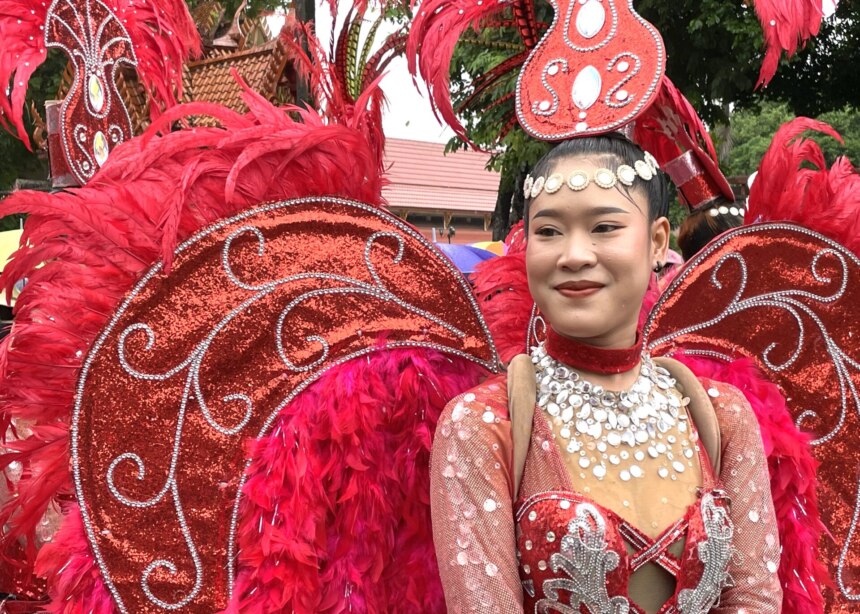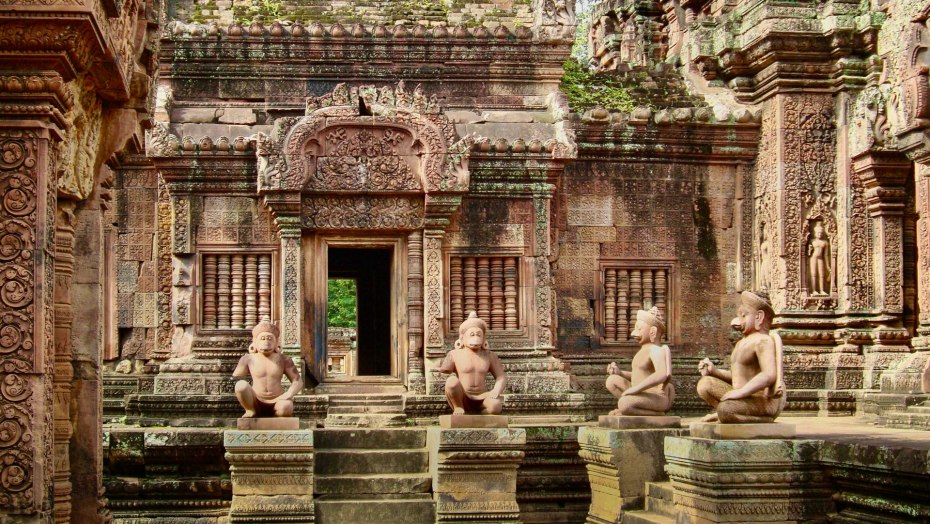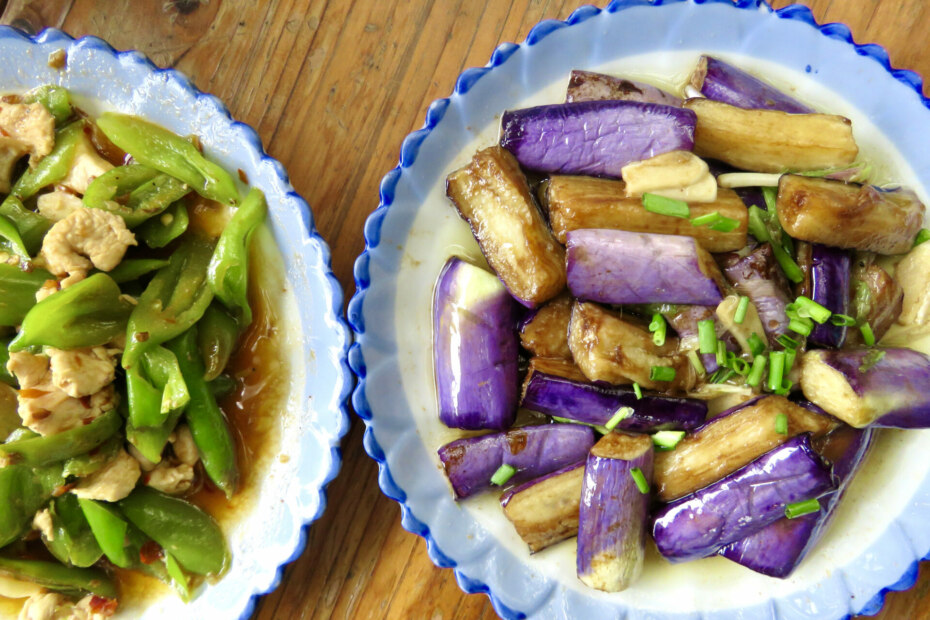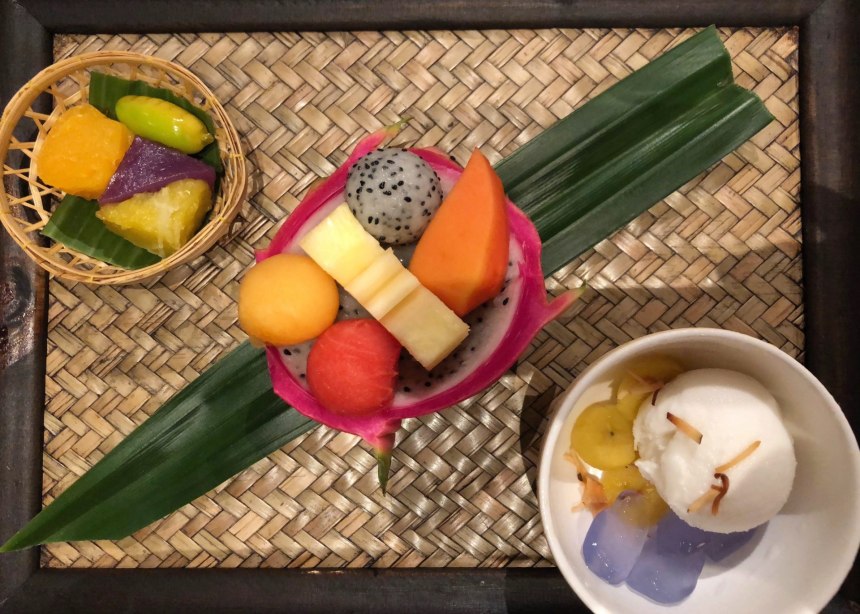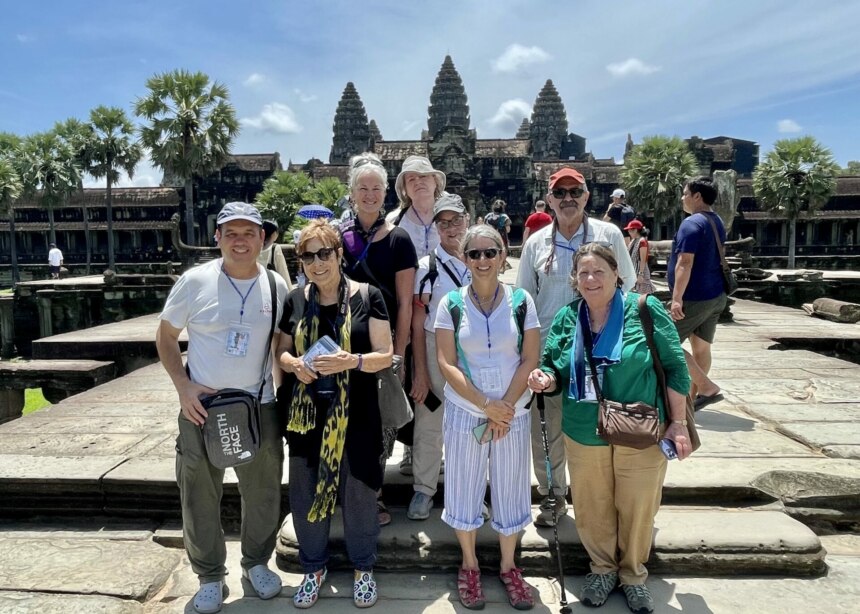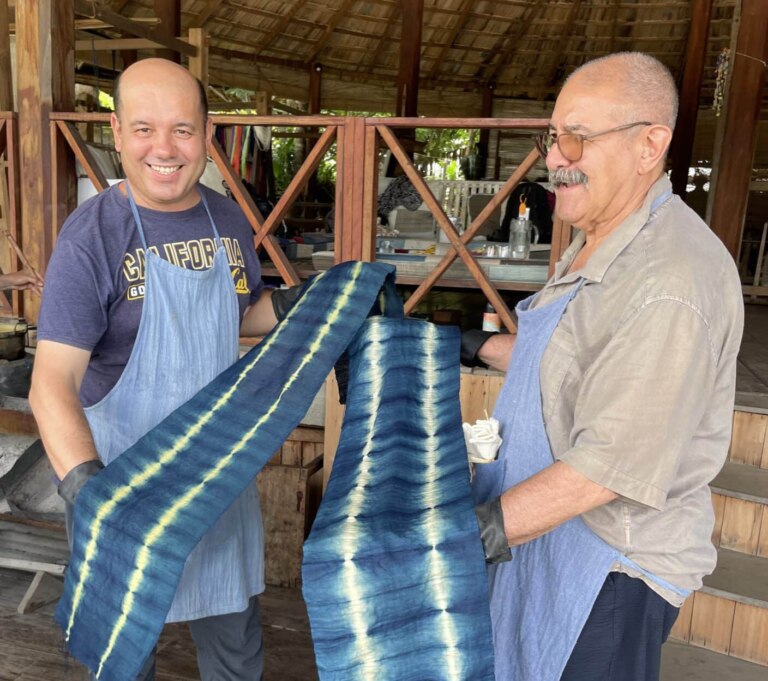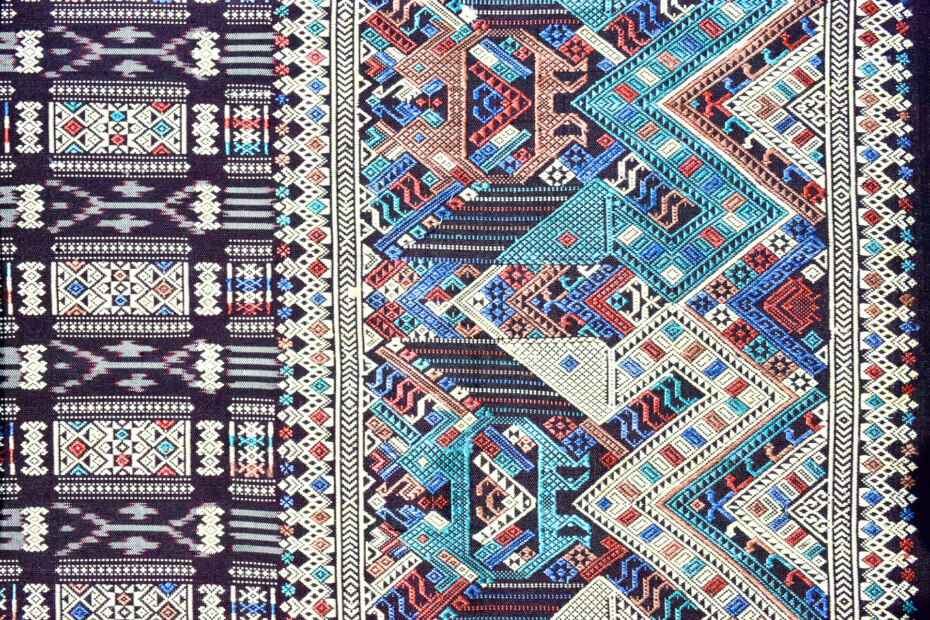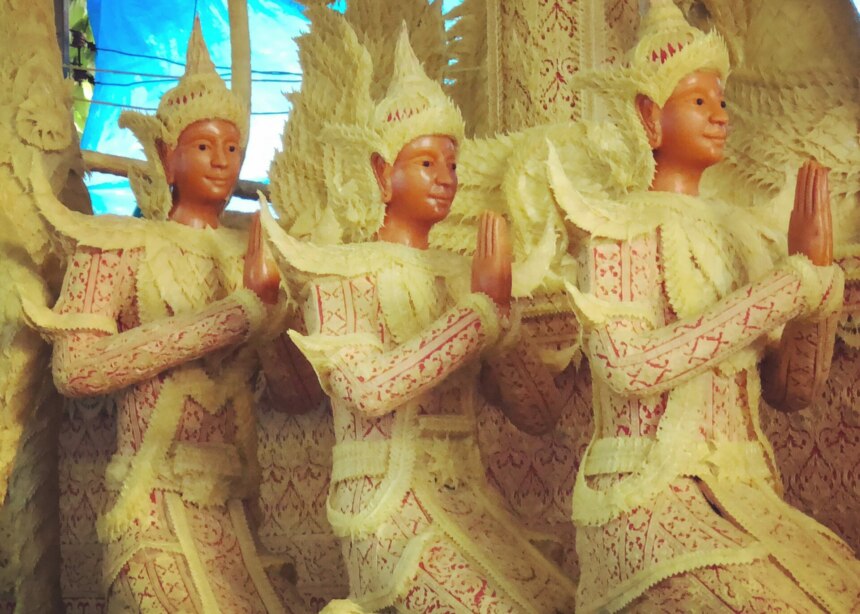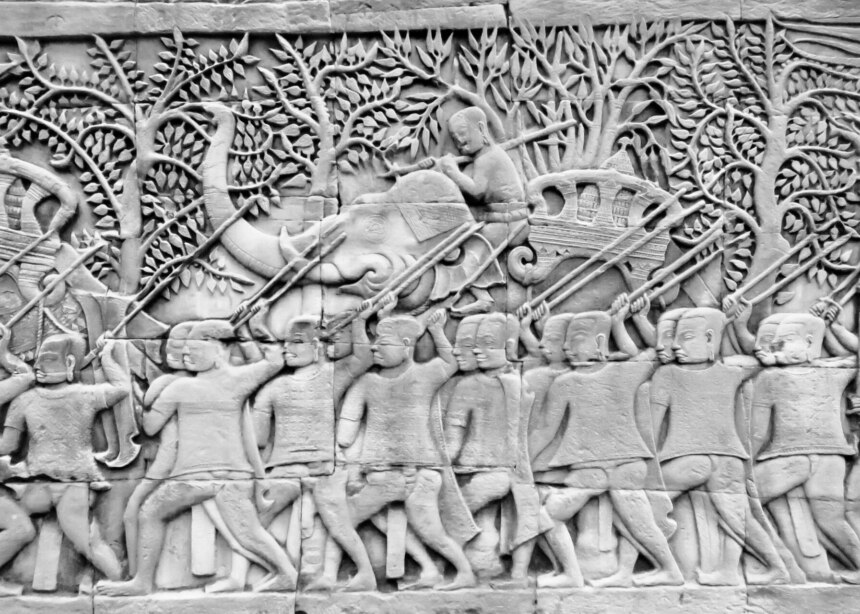Come and enjoy the best of all three countries: the most interesting textiles, festivals, architecture, and archeology, including UNESCO World Heritage sites.
Some serious bucket list destinations are included on this 19-night trip, such as the ancient Khmer complex of Angkor Wat, and the royal city of Luang Prabang with its golden temples.
And the textiles are superb! First we’ll see the Lao textiles, then later the textiles of Thailand and Cambodia. In all three countries we’ll meet indigo ikat weavers at work, and learn about their dyeing methods on silk and cotton. In their studios and in the markets, we’ll see stacks of stunning handwoven ikat-patterned textiles.
We’ll attend the Wax Candle Festival or Khao Phansa in the north. This exciting event showcases some of the country’s best artistry with hand-carved wax Buddha figures. Festively decorated parade floats carry scenes of golden life-sized wax figures in procession through the streets of the city.
Last exciting destination is the huge Khmer Angkor Wat temple complex, a UNESCO site on most everyone’s list. Angkor is one of the most important archaeological sites in South-East Asia. Angkor Archaeological Park contains the magnificent remains of the different capitals of the Khmer Empire, from the 9th to the 15th century.
TRIP HIGHLIGHTS
- See the UNESCO sites of Angkor Wat in Cambodia and the golden Buddhist temples of Luang Prabang, Laos
- Watch weavers in all three countries make fabulous hand-woven silk and cotton ikat textiles
- Attend the traditional Wax Candle festival or Khao Phansa, in little-visited NE Thailand
- Learn to weave silk or make natural dyes at the Ock Pop Tok textile center in Laos
- Make and devour a gourmet lunch in our Cambodian cooking class.
What’s Included in The Trip?
An Overview of Your Journey
From the city to heaven!
We first fly into Bangkok and spend the night near the airport to rest a bit. Next morning we fly together to the ancient royal capital, Luang Prabang, now designated a UNESCO World Heritage site. We’ll check into a comfortable hotel right next to the tranquil Mekong River. Next day, with a local friend and licensed guide (who was a monk for 10 years!), we’ll walk around the charming and laid-back town to explore the golden wats or Buddhist temple complexes. With our guide we’ll visit the most important wats and learn about the Lao version of Buddhist practices. You’ll also be able to explore this relaxed, safe and friendly town on your own. Time to soak up the tranquil, tropical ambiance!
We will spend spend a morning at the textile center of Ock Pop Tok where we’ll chop wood chips and extract seeds from prickly achiote pods, and learn to make several colors of natural dye. We’ll be able to watch talented silk weavers and have a delicious gourmet lunch at their restaurant by the Mekong River.
We’ll take a morning to visit the excellent new Luang Prabang textile museum. Exhibits show typical indigo ikat and other weaving from all over SE Asia. And after dinner one night we’ll stroll through the nearby Night Market to check out the textiles and other crafts. The magnificently decorated golden temples, the riverside location and the tropical ambiance make Luang Prabang a delightful place to relax for our introduction to Lao culture.
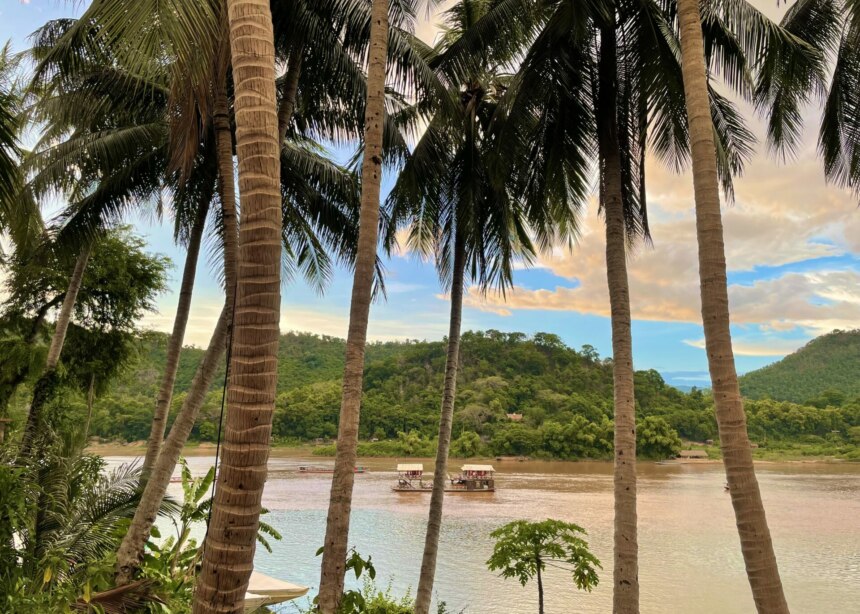

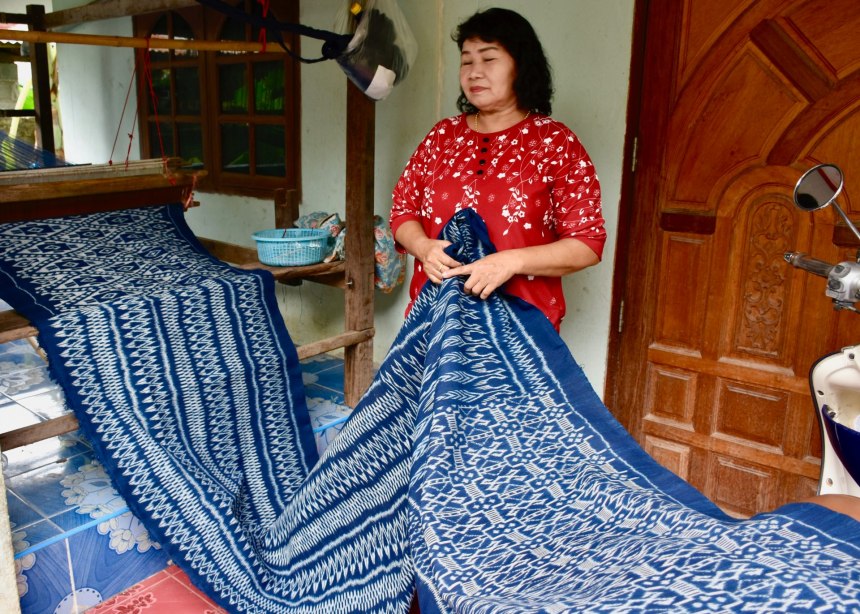
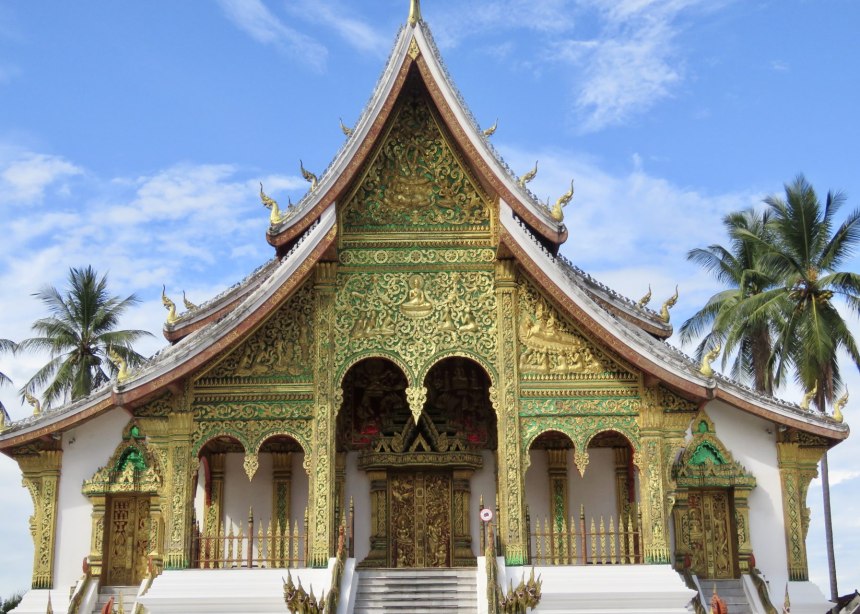
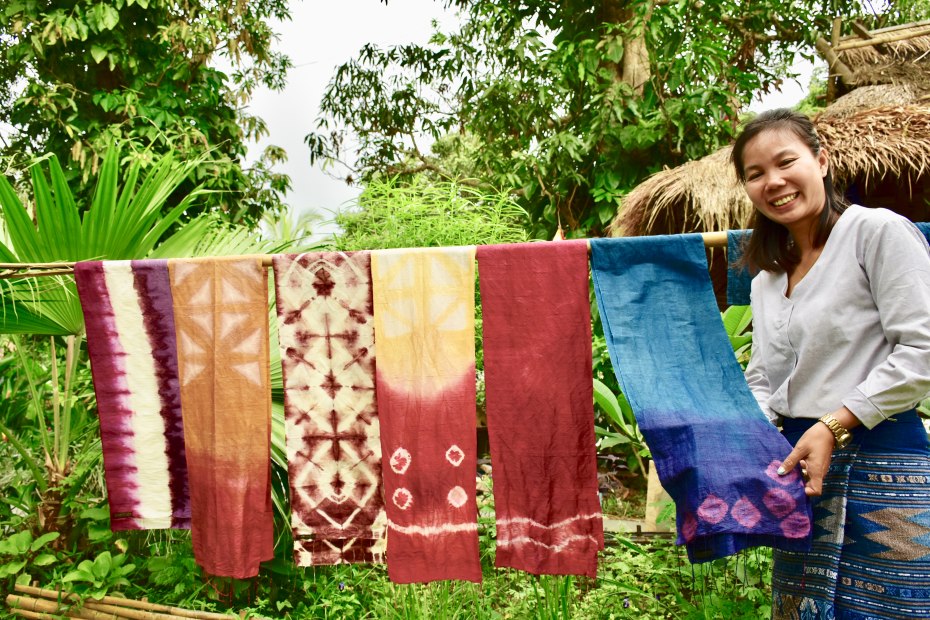
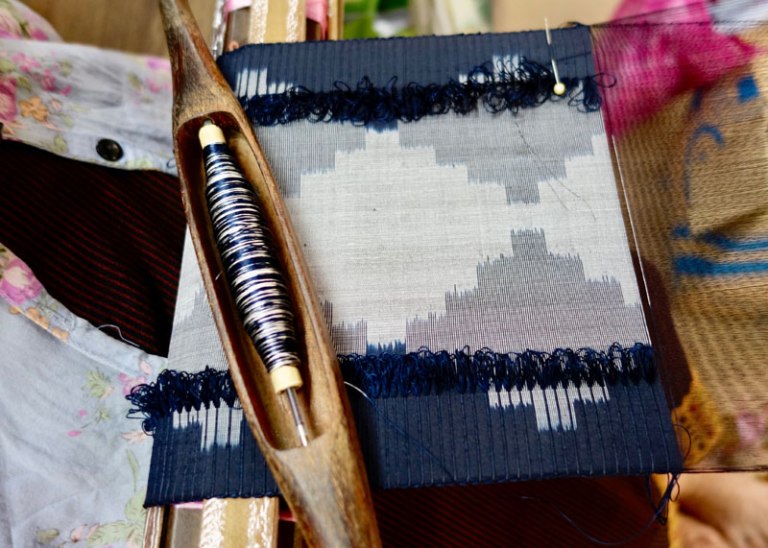
Vientiane and into Thailand
After relaxing in Luang Prabang with all the golden temples, we fly south to the pleasant riverside capital, the city of Vientiane. We’ll visit the enormous Salat Tao, the Morning Market for locals, with its many stalls of exquisite examples of silk weaving. We’ll also tour the innovative silk weaving studio called Lao Textiles, started by American fabric designer Carol Cassidy who helped revive Lao silk weaving. Vientiane also has fabulous wats (Buddhist temple complexes) such as the ancient wooden Wat Si Saket, with its 10,000 brass and wooden Buddha figures.
Leaving Laos, we’ll drive across the Friendship Bridge over the Mekong River. We’ll stop to get our passports stamped on arrival at the Thai border. This lovely agricultural countryside of NE Thailand is called Isaan and is one of the most exciting parts of our textile tour of Thailand! The area is home of indigo ikat weaving or as the Thai and Lao weavers say, “mat-mi” or “mud-mee” patterns. Most indigo-dyed cloth here is woven from cotton, patterned with dark blue geometric weft ikat designs.
We’ll visit friends who dye the cotton threads with natural indigo. These Master dyers will show us their indigo pots and their tying and dyeing methods, as well as the indigo ikat weaving process. We’ll start to understand the complex technique of tying off specific areas of the weft threads to resist the dye. Later we’ll see an infinite variety of silk ikat designs. The weavers love to show off their skills and these visits are fascinating.
Khon Kaen, Land of Silk
On our way south, we’ll visit nearby indigo ikat weavers and a famous silk ikat museum there. The museum has a superb collection of multicolored handwoven silk examples, many with tiny 1/8″ patterns that were tied into the weft threads before dyeing.
Then we’ll continue to the site of the Wax Candle Festival or Khao Phansa; see article explanation below. Floats are interspersed with groups of musicians and dancers in local festival dress. The yellow wax figures and decorations that adorn the floats are very labor-intensive. The float decorations can be either carved in place as the example at right – or else the monks roll out flat lacy thin pieces of ivory wax, cut them out carefully, then attach them to the figures on the float. Typically monks and lay people work on the floats until the very last minute when it is scheduled to roll onto the parade route. We will arrive a day or two in advance so we can watch the final decoration and assembly of the figures – and perhaps we can even make merit by helping.
The town also has some very unusual Buddhist wats that we will visit to see the architecture. One is shaped like a long boat and another is Chinese style, encrusted with glazed colored ceramic floral and dragon images.
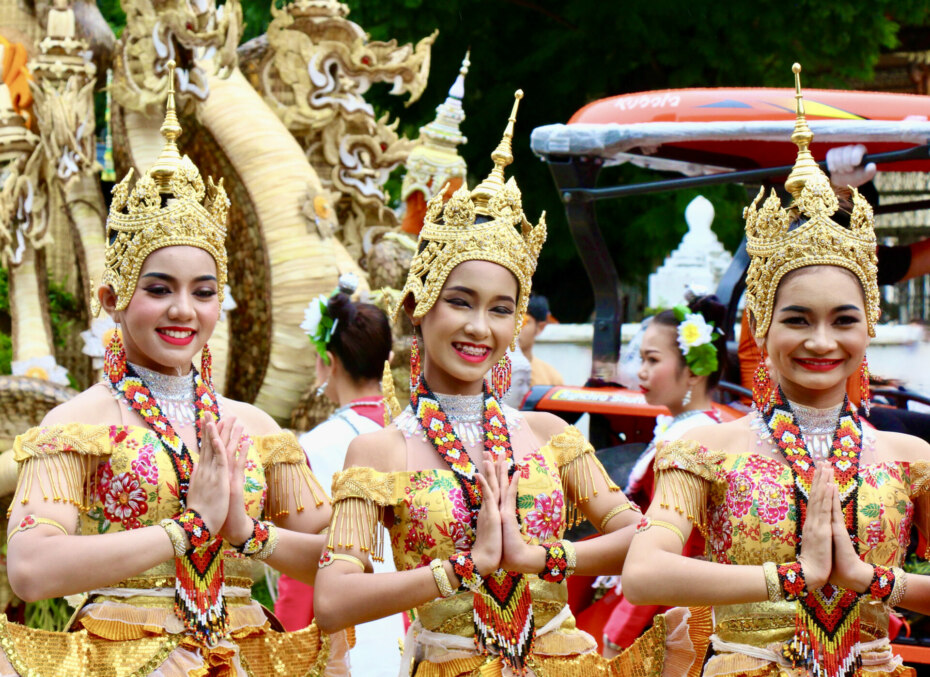
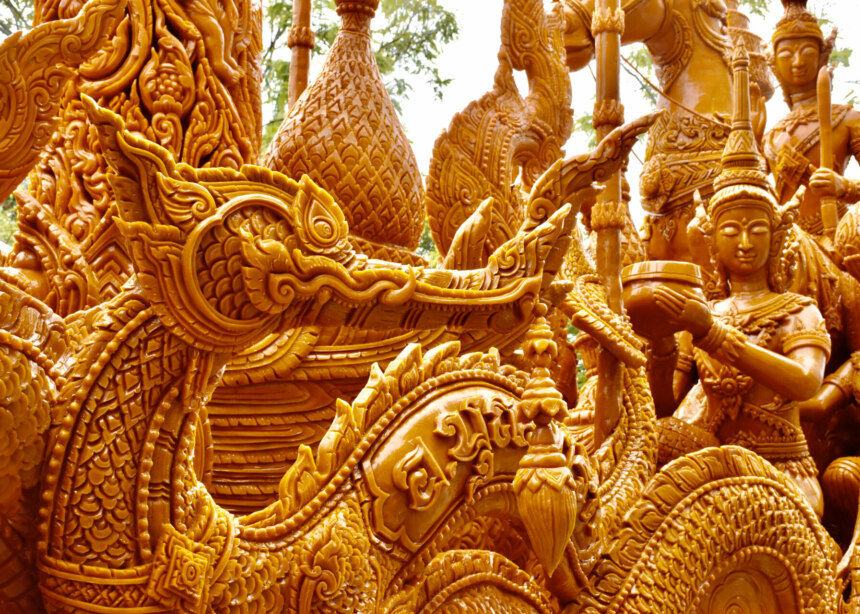
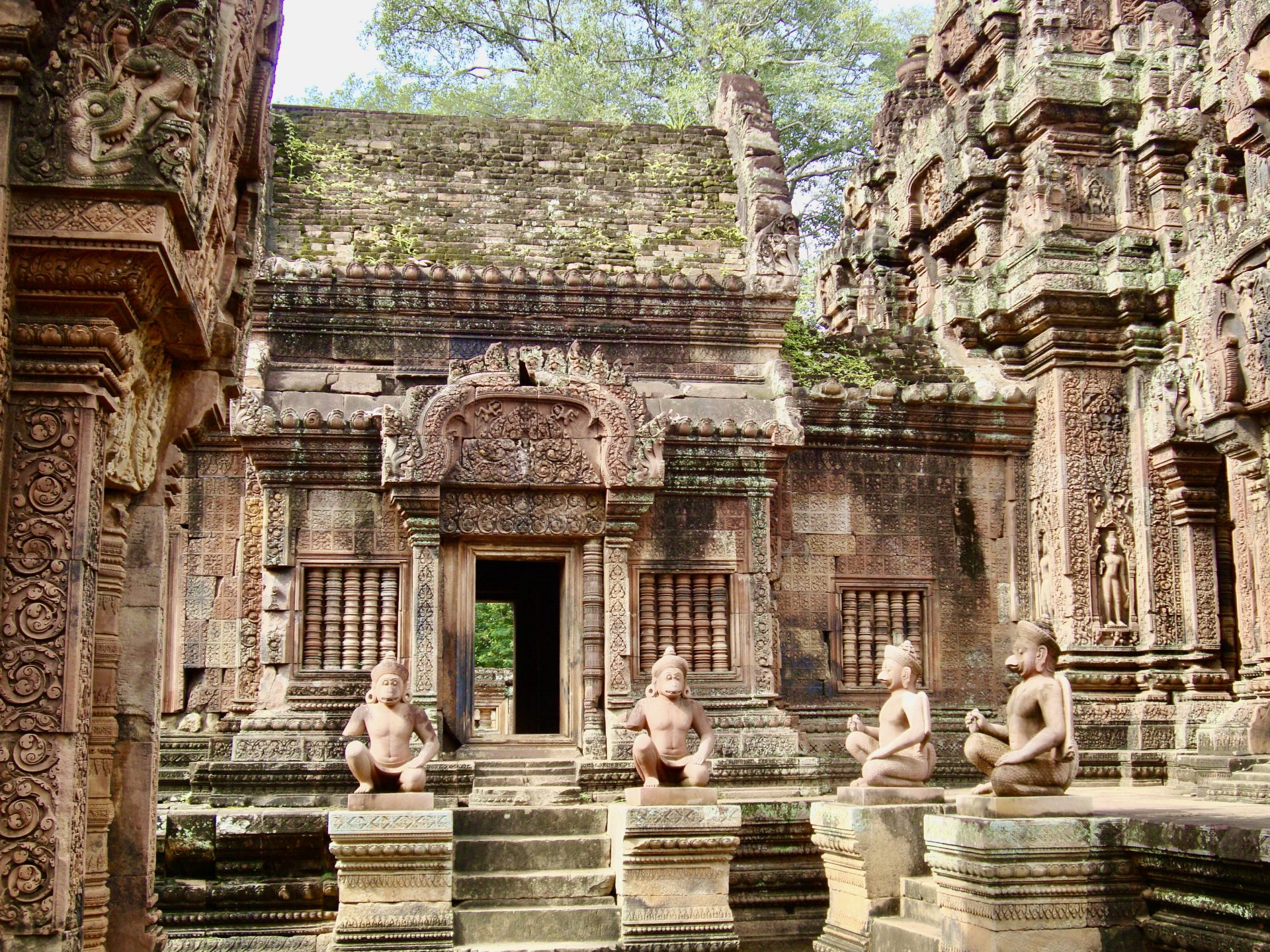
Angkor Wat Complex and Siem Reap
From Ubon, we’ll head across the southern border into Cambodia, to Siem Reap, to see the fabulous Angkor temple complex. Considered the most important archaeological site in South-East Asia, it contains the magnificent carved stone temples of different Khmer rulers, from the 9th to the 15th century. This UNESCO World Heritage site has sophisticated bas-relief wall carvings and turned stone columns. We’ll go from temple to temple in a van or tuk-tuks, then explore each one. Many have steps to climb but it’s always possible to appreciate a temple from outside. A professional guide will explain each stunning site. If you haven’t had enough, you may return on your own with a tuk-tuk and/or guide for the third day’s visit also!
Cambodian Cooking Class and Phare Acrobatic Circus
Siem Reap itself is an easy and interesting town to explore, and has some excellent restaurants. One morning, we’ll learn the subtleties of delicious Cambodian cuisine (similar to Thai) in an optional hands-on cooking class. We’ll visit the produce market to learn about the more unusual ingredients. Then we each choose some appealing menu items, and make our lunch. Another day we’ll head for the excellent Textile Museum; it has displays of woven pieces from Cambodian plus other countries.
We’ll attend an exuberant performance of Phare, the renowned Cambodian youth circus – no animals – but great acrobatics by young people! It’s described as “Circus-style entertainment featuring high-flying acrobatics with live music.” Phare performers use theater, music, dance and modern circus arts to tell uniquely Cambodian folk stories. The young circus artists will astonish you with their energy, enthusiasm and talent.
The Phare association was formed in 1994 by 9 young men coming home from a refugee camp after the Khmer Rouge regime. They wanted to help poor, socially deprived, and troubled youngsters, so they founded an art school, then a free public school, a music school and a theater school – and finally the circus school. Today more than 1,200 pupils attend the public school daily and 500 attend the alternative schools. The Phare circus performance that we will attend helps fund the schools. Bravo!!
On our last night, we’ll have a surprise dinner and say Farewell to new friends and old. We’ll fly out of Siem Reap’s brand-new airport to Bangkok and then home, remembering our great adventure!
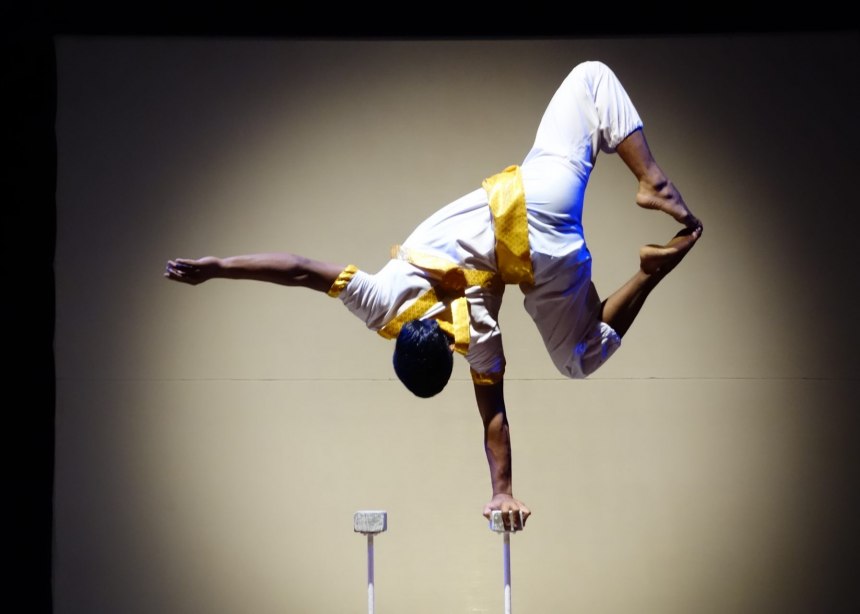
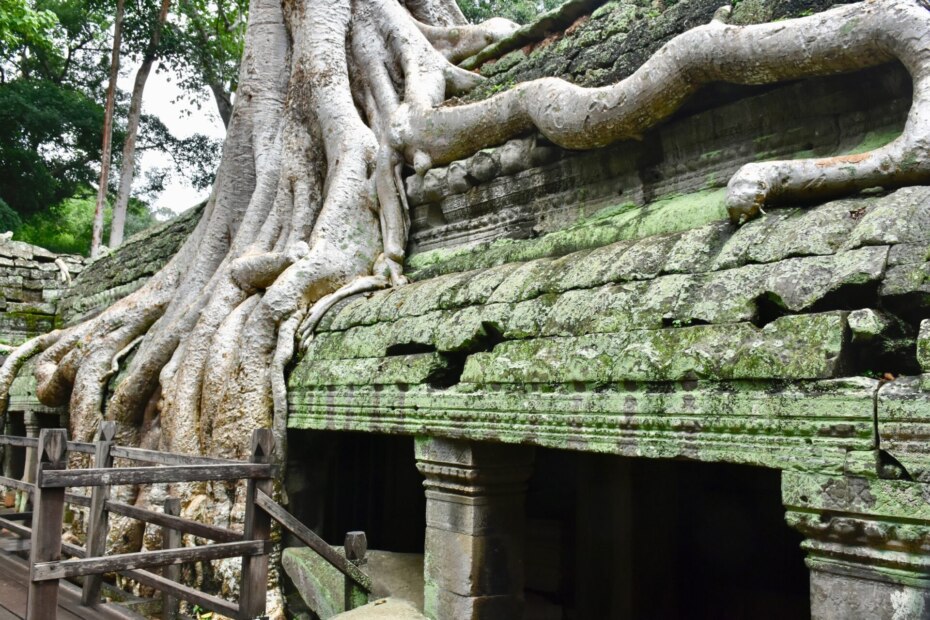
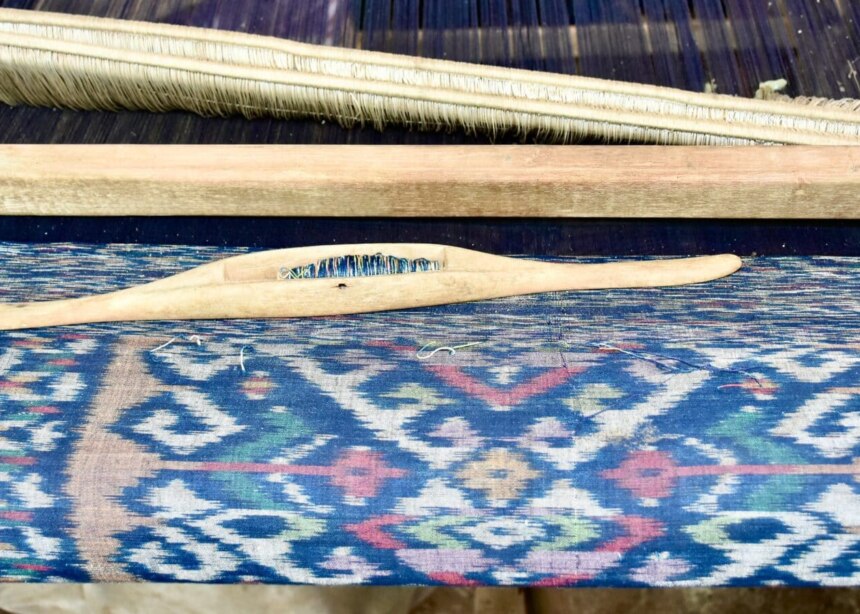
Some of our hotels…
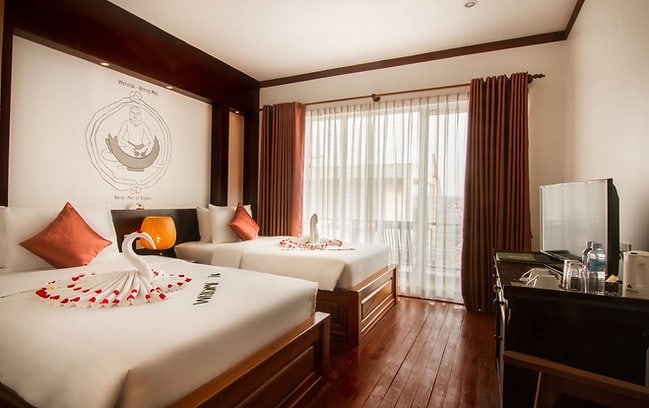
Siem Reap Hotel
Beautiful tropical hotel with pool and comfortable rooms. It’s situated in a quiet area of town but very close to the Night Market and central happenings. We can walk to nearby cafes, our cooking class, and shopping in 5 minutes.
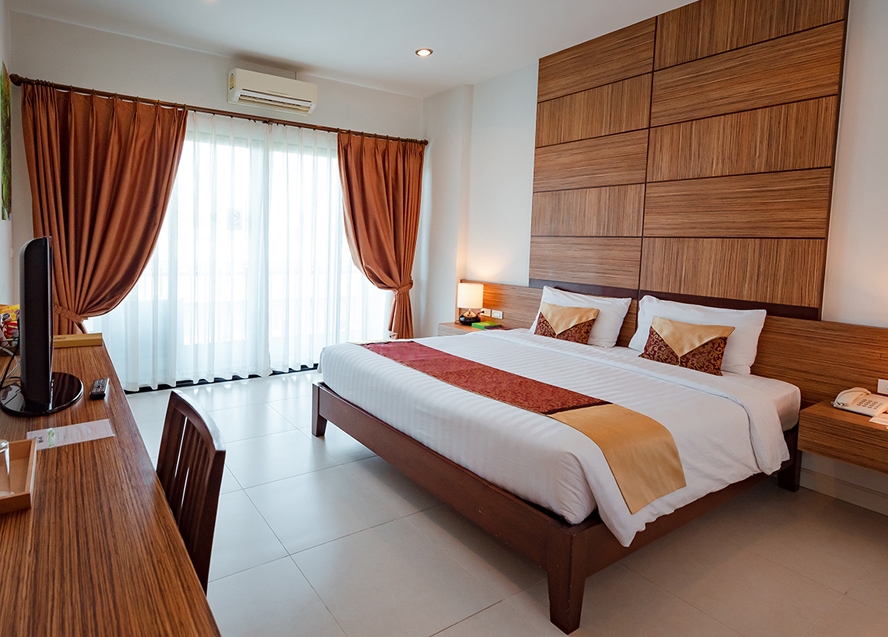
Hotel in northern Isaan
Pretty hotel in a sunny setting conveniently located in the center of town. We’ll relax with comfortable, airy rooms and a large pool. An on-site restaurant and helpful, friendly staff ensure a pleasant stay.
Additional Details & Experiences
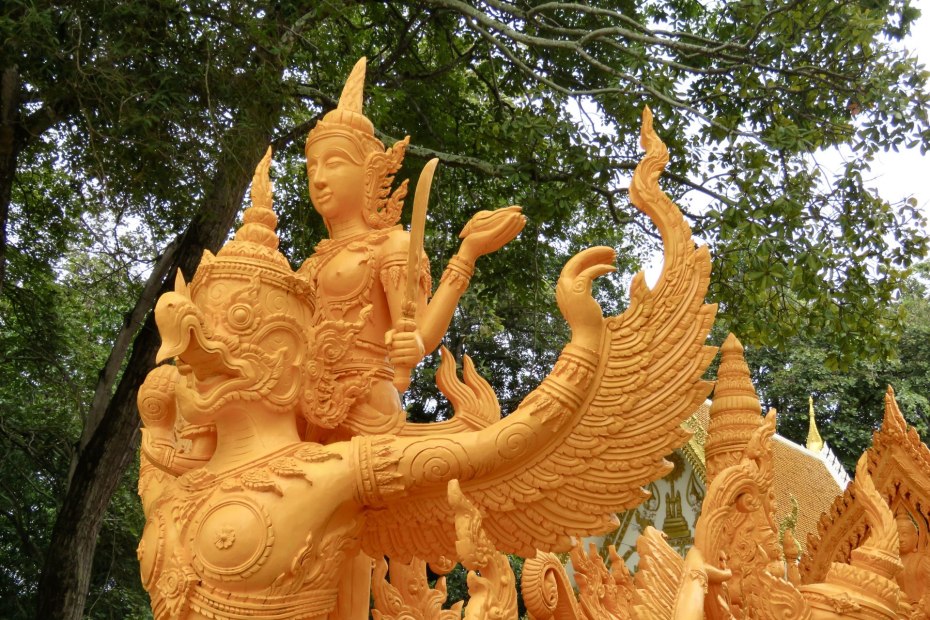
Wax Candle Festival
Every July, the riverside town bursts into celebration mode for the fabulous Wax Candle Parade. The Thais call it Khao Phansa, or start of the Buddhist Rains Retreat. This is the 3-month period when monks stay in the monastery to study and meditate. Candles are offered to the monks to symbolize Light: the times before electricity when they read by candle light.
The festival consists of a long parade of new tractors pulling long flat-bed trailer “floats” covered with wax figures. We’ll arrive a couple of days early to visit friends finish the incredible wax floats to be paraded in the event. Both monks and lay people spend hours working on the wax decorations, achieving Buddhist merit by carefully trimming the wax shapes to embellish the sculptures.

Indigo Ikat Dyeing & Weaving
Resist dyeing or ikat is known as mat-mi in Thailand and mud-mee in Laos and Cambodia. Weavers and dyers in all three of the countries that we’ll visit create beautiful and labor-intensive handwoven cloth. In Thailand we’ll learn how dyers ferment a natural indigo dye bath, adding fruit such as star fruit to ferment thus keeping the indigo mixture ‘alive’ for years. We’ll also see what fixatives they employ with the natural leaf mixture. Artisans there specialize in cotton indigo ikat (tied on the weft) as well as silk. We’ll see how some weavers use a plain warp and change weft patterns every few yards!
Weavers in Laos and Cambodia also create fine resist-dyed (ikat) patterned cloth, often with natural colors.
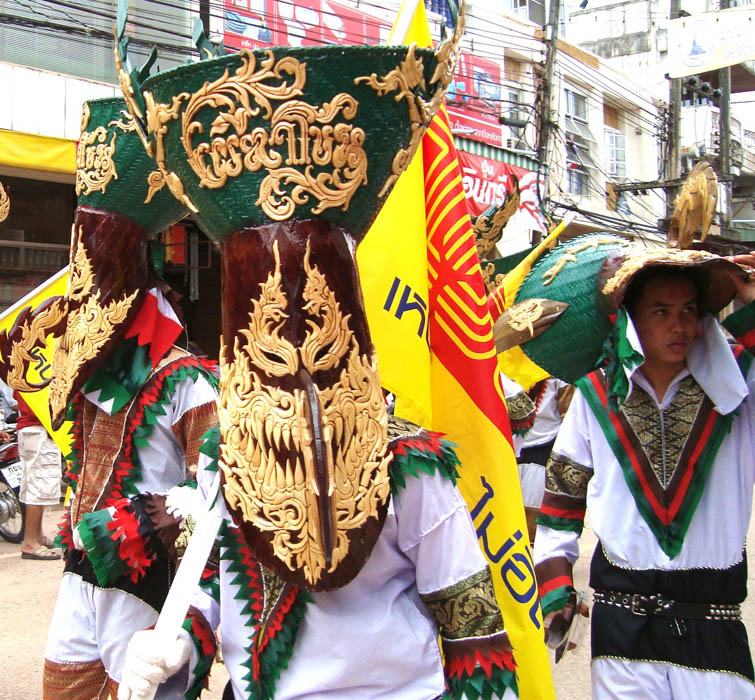
Phi Ta Khon Festival
(Festival available only in certain years.) Working between an age-old aesthetic and innovative new styles, the mask painters create stunning festival art for this animist/ Buddhist event. Phi Ta Khon relates to celebrations asking for rain and fertility for crops and people (thus plenty of phalluses as dance batons!). The name Phi Ta Khon means Ghosts Following People and we’ll learn about the festival’s significance. Masks are made from a painted and deco-rated coconut palm tree sheath, with a sticky rice steaming basket stitched on top. This festival takes place in a small village; we alternate trip dates between Khao Phansa and Phi Ta Khon. Usually there is about a month between the events so we can’t experience both in one summer trip.
I have been to Thailand, India, Mali, Turkey, Cambodia, Laos and Bolivia with Cynthia. Every trip has been a wonderful adventure. She has personal contacts all over the world who add to each trip's story.She is very knowledgeable about all things textile. Each trip has always had great company and great food.
Kathy P – Los Angeles, CA
Your Trip Leader
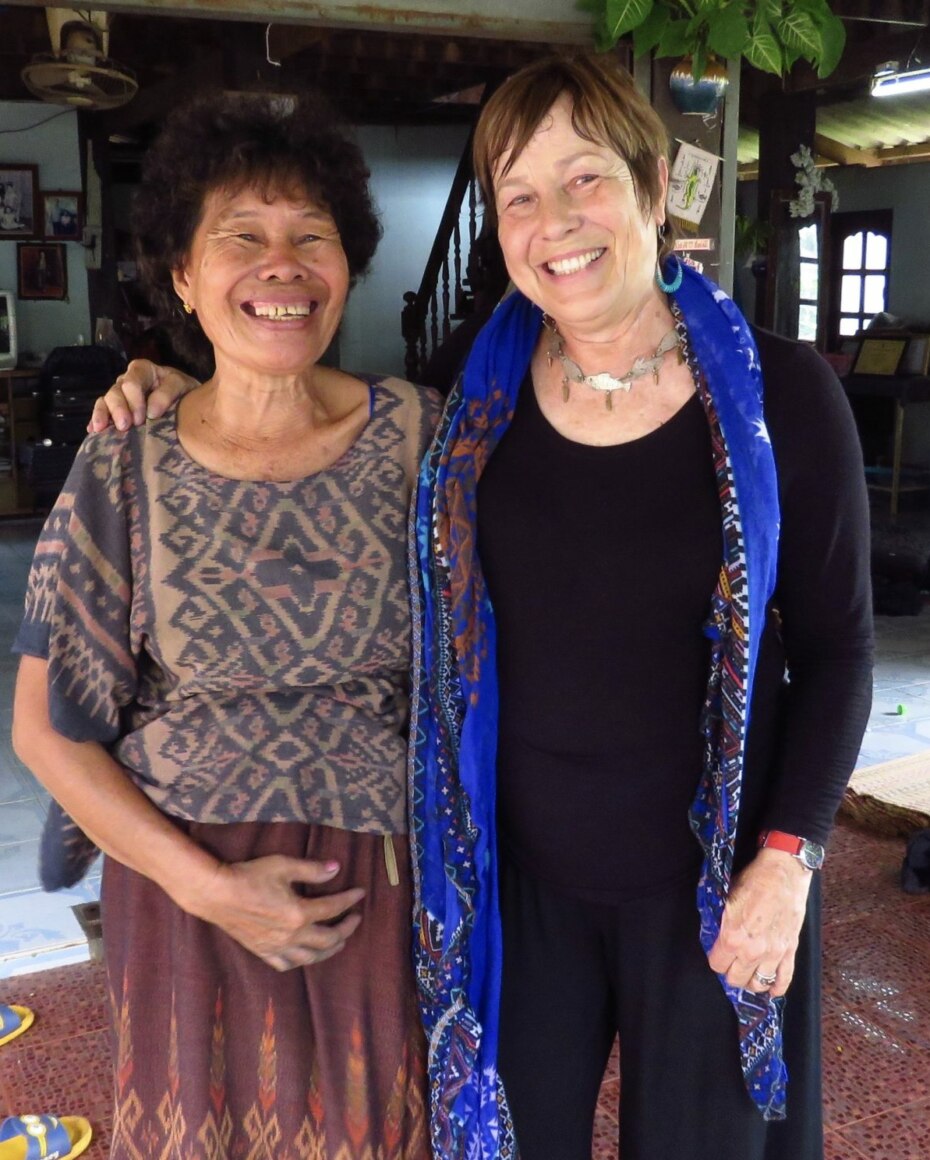
Cynthia LeCount Samaké
Thailand, Laos and Cambodia are tried and true destinations that Cynthia has explored many times over the past twenty years. She counts dozens of friends among the dyers, weavers, guides, drivers, and restaurateurs; these connections make the Southeast Asia adventures personal and authentic. Cynthia will be joined by expert licensed local guides at important sites such as Angkor Wat Park and Luang Prabang and an English-speaking tour assistant.
She began “Behind the Scenes Adventures” to share with others the traditional textiles and festivals of far-flung countries such as Laos and Cambodia. Since 1998 she and her expert guides have led small groups of textile fanatics and friends all over the world.
Check Trip Availability
Trip signups are accepted on a first-come, first serve basis. Please provide your details below and we’ll be in touch to confirm whether spaces are still available for this trip. If you need to get in contact, please email: info@btsadventures.com
Registration Information
- Dates: June 29 – July 17, 2025
- Fly Home Date: July 18, 2025
- Deposit: $500
- Tour Cost: 19 Nights from $5695
- Single Supplement: $750
For more information:
Phone: 707-939-8874
E-mail: info@btsadventures.com
Read: Frequently Asked Questions
IMPORTANT: Travel Plans
You can search for international flights to Bangkok’s BKK Suvarnabhumi Airport on orbitz.com or expedia.com, or talk to a travel agent who can help with your itinerary. You may need to leave home a day or two before June 29 to arrive on the 29th; check the dates carefully.
Arrive in Bangkok anytime on June 29. Connect to home flights on July 18.We will let you know the flight schedule so you can plan Please plan to depart Bangkok (BKK) sometime in the late afternoon of July 18.
So plan your departure to home from the BKK Suvarnabhumi Airport anytime after 5 or 6:00 pm. (If you end up with a terribly long connection, the next-door Novotel Hotel has day rooms where you could sleep for a while; see their website once you have your plane ticket.)
Visas
Thailand doesn’t require a Visa for travelers from most countries; check for yours. Both Laos and Cambodia issue easy visas upon arrival – whether at the airport or at the land border when we cross. These two cost $30-$40 each and you will need to bring 2 passport-size photos. Last trip they didn’t actually use these photos but please bring two just in case!
What’s Not Included
- International round-trip airfare to Bangkok
- 2 Drivers’ tips (count on about $150 total per person)
- Your visas upon arrival [Laos USD $35 and Cambodia USD $40] at the airport or at the border when we enter
- Alcoholic beverages
- Several meals are ‘on your own’ per the itinerary
What’s Included
- Tour begins June 29 with a night at a convenient hotel near the Bangkok airport. The next day June 30 we fly to Luang Prabang. The trip ends in BKK on July 18 after the flight from Siem Reap.
- Included TWO group flights: From BKK to Luang Prabang (LPQ) and from Siem Reap (REP) to Bangkok at the end.
- TRAIN journey: Luang Prabang to Vientiane
- Connect to home flights in afternoon/night of July 18; check with us before buying air ticket for time of flight arrival from Siem Reap.
- 19 nights in comfortable A/C hotels – charming boutique hotels, and a modern one in Bangkok
- All meals except four – two lunches and two dinners on days when the group is “on their own,” during the Candle Festival for instance.
- All soft drinks and bottled water with meals.
- We will have bottles of water available in the van for all day trips
- All land travel by private van with professional driver
- Three days of entrance tickets to Angkor Wat
- Transportation in the Angkor Wat Park and English-speaking licensed guide for 2 days. (Another day w/ guide is optional on your own; you’ll have tickets to enter the site for 3 days.)
- Tips for Luang Prabang and Angkor temples guides
- Entrances to temples, archaeological and museum sites on the itinerary
- Cambodian cooking class in Siem Reap; your choice of dishes to make for our delicious lunch.
- Phare circus – Acrobatic show in the town of Siem Reap; no animals! A wonderful show of amazing and talented young acrobats.
Frequently Asked Questions
General Questions
What information will I receive after registering?
Once you sign up for a trip, we will e-mail a general itinerary, lists of Suggested Reading, what to take, cultural considerations, weather charts, etc.
How can I get a detailed itinerary for a tour?
A day-to-day itinerary will be sent once you sign up for a trip. If you need specific information about the flow of the trip and the pace of the specific activities, before committing to the trip, get in touch with your questions and we will be happy to fill you in.
What sort of clothing should I bring?
When you sign up for a tour, you’ll receive detailed lists of what to bring to your destination, as well as weather info, to more easily coordinate your wardrobe with the heat or cold.
We will also include suggestions for appropriate clothing for dressing in conservative countries. Basically you’ll need modest clothes that cover your shoulders and legs. Be comfortable, in light cool clothes you would wear to go out in the USA. Shorts and short pants are not appropriate for tourists, men nor women. Thai women wear dresses and skirts with blouses. Please keep your legs covered to below your knee.
Light cotton clothing, like long, loose pants and blouses with short sleeves, is perfect. Skirts at least knee-length are also comfortable with a nice T-shirt. Long dresses with short sleeves are also practical. Sleeveless tops are not considered in good taste for visiting temples and homes. Slip-off shoes will be easier to slide on and off when we visit a temple where we must be without shoes. We’ll send out a more complete list of What to Take at a later date, including the luggage size limits.
Are laundry services available?
Most hotels have a laundry service and prefer that you don’t wash clothes in the bathroom sinks. If there is no laundry service, and you don’t want to wash your jeans and wait a day or two for them to dry, asking at the hotel desk is a good place to start.
Please note that it is considered demeaning to wash someone else’s underpants, so we ask that you wash your own underpants. Hang them to dry discreetly in the bathroom.
Are laundry services available?
Most hotels have a laundry service and prefer that you don’t wash clothes in the bathroom sinks. If there is no laundry service, and you don’t want to wash your jeans and wait a day or two for them to dry, asking at the hotel desk is a good place to start.
Please note that it is considered demeaning to wash someone else’s underpants, so we ask that you wash your own underpants. Hang them to dry discreetly in the bathroom.
Do I need any vaccinations or immunizations?
This varies with each country. Make an appointment with your travel doctor/clinic and take your tour itinerary with you. Some areas of certain countries require malaria pills and others do not; same with Yellow Fever and others, such as Cholera and Typhoid. The travel nurse or physician will have all the latest requirements at hand.
OR You can consult the CDC.gov (Center for Disease Control) website information pages for your specific destination so that you have the latest official information.
For all travel, you should be current on your typical childhood and international travel shots such as Polio and Tetanus. Some countries require proof of Yellow Fever vaccination for entry, if you are coming from a country that has yellow fever.
Behind the Scenes Adventures requires you to have had at least two COVID vaccinations. We won’t ask for proof; this requirement is on the Honor System. We recommend you have all available boosters as well.
How much physical activity is involved during the trip?
You should be able to stand and stroll around markets and museums for several hours at a time. Most indoor venues such as our hotels, restaurants and museums have air-conditioning. Most days will involve some walking around towns on paved streets, but the sidewalks are sometimes broken and rutted. We’ll take our van or taxis for any long distances out to see the Buddhist temples and wats, or archeological sites.
The days involving the most exercise (at your own pace) will be at the Angkor Wat temple complex. These extensive and glorious ruins involve lots of walking, usually along hard dirt pathways. Closed toe shoes with good tread are important for climbing slippery stone stairs and walking in the jungle. There will always be the possibility of moving slowly in the heat and taking frequent breaks for cold water and iced teas. Bring a collapsible walking stick if you think you might need one.
What will the weather be like?
You will receive weather and temperature information with your pre-departure info. We will be traveling of necessity (for the festival) during the hot and humid June-August tropical rainy season, at least in Cambodia and Laos. Thailand is warm and humid with less rain during this season. Don’t be too alarmed, the hotels and most restaurants are air-conditioned. There are distinct advantages to traveling during this “rainy” season: the monsoon rains cool the hot, humid air, and there are fewer tourists.
Across most of the country, the rain is fairly predictable, usually occurring in the afternoon or at night. And the afternoon rains usually last no more than a couple of hours making them fairly easy to plan around, especially if you are visiting the Angkor temples. In fact, the temples are at their aesthetic best during the wet season because the stones are dark and gleaming and the tropical foliage of the surrounding jungle is clean and shiny. Some people bring a little personal battery-operated fan which helps.
Meals & Accommodations
What sort of hotels will we be staying in?
Before we depart, we will send you a list of all hotels with contact information in case someone at home needs to contact you. They are all pretty, tropical, and comfortable, with air conditioning, and sometimes a small pool.
What sort of food will we be eating?
Starting with breakfast, the three countries have excellent choices of coffees and pastries. Siem Reap and Luang Prabang especially have numerous amazing coffee shops that are spotless and airy, and serve the best coffees, with crispy, fresh croisssants or other breakfast foods.
When you arrive, we’ll give you a list of easy translations and common dishes to order for lunches and dinners. Food in all three countries that we will visit is superb, with lots of variety, and many unusual but delicious ingredients. On our trips, we are careful to patronize known, clean, and friendly local restaurants and cafes. Local cuisine specialties are integral to our travel experiences and are unique to the regions we’re visiting, so we want you to be able to taste as many traditional and typical dishes and condiments as possible. Our driver, Chai, loves to eat and helps choose the best combinations.
Sticky rice or Khao Niaw is eaten everywhere in Thailand and Laos, usually with delicious stir-fried vegetable and coconut milk dishes. There are many cold or room-temp salads such as Laab, or minced meat/chicken seasoned with lime juice and chili, crispy rice salad, or Green Papaya Salad which you will find delicious if it’s not too blazing-spicy. Steamed fish with coconut milk in banana leaves is superb, often served with noodles or sticky rice. Deep-fried tofu and grilled chicken (gai yang) are common items. Pad Thai and Pad See-Ew Gai are traditional and delicious (but common and simple) Thai dishes, consisting of rice noodles, vegetables, spices, and egg and/or chicken pieces. Sticky rice and fresh mango is one of the most common desserts too.
Will I be able to accommodate my dietary needs?
If you have any special dietary, health, or nutrition issues, restrictions, etc, there is no guarantee that
Behind the Scenes Adventures will be able to accommodate your special diets in foreign countries.
Please contact us before departure, and bring sufficient alternative foods. Travelers with severe peanut allergies or other life-threatening allergies cannot be accepted. Vegan diets are possible but with much less variety than at home. Vegetarian or gluten-free diets are often fairly easy to accommodate, but also with less variety than what is available at home. Note that the guide and tour leader cannot cater to your special diet in a group; you’ll be responsible for choosing foods you can eat.
The cuisine of all three countries includes many delicious vegetable, noodle and rice dishes. Simple fruits are often served for dessert. Much of the time, you will be free to order the vegetarian dish that you want; sometimes the guide will order family-style so we can share and you can taste different items.
Flights & Travel
Will I need a visa for connecting countries?
It is very rare to need a visa for a connection if you stay in the Transit area. This will be regulated by the connecting country and the airline will send information as to this requirement.
What are the requirements for my passport to be valid?
Your passport needs to have one blank page for your visa, although, with an E-Visa, you will have just a piece of paper to show, and don’t need room for anything except Immigration stamps in your passport.
Your passport must remain valid (not expired) for 6 months after you enter each country.
Will I be met at the airport?
Yes! A driver (and the guide if possible) will meet you with a sign – beariing your name and/or Behind the Scenes Adventures. The driver will have your flight schedule and he will know that you need time to pick up your luggage. Wait for him in the terminal, right outside the Arrivals area, and don’t go with any other drivers that don’t have your name on a placard.
For each trip, we’ll send more specific info about the exact pick-up spot. The driver will help with your luggage and a small tip of $5 USD would be appreciated anywhere..
What is the best airline to fly to the country?
Basically you will need to get to Bangkok, but because of COVID, the flight rules have changed. We will send information about suggested flights at a date closer to departure. Typically United flights partner with ANA, for some good pricing. Japan Airlines also has excellent prices to Bangkok from the US West Coast.

